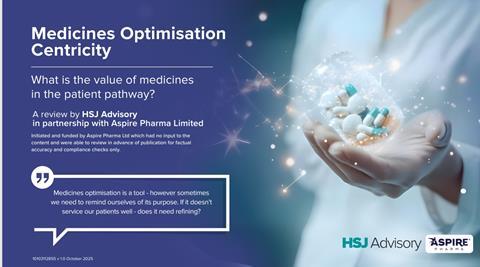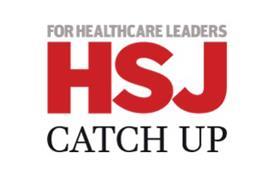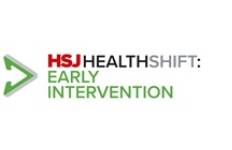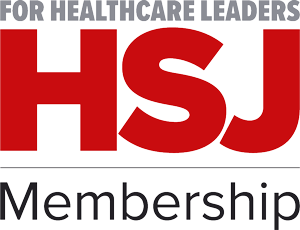Aspire Pharma Ltd initiated and funded this article but had no input into the content and was able to review it in advance of publication for factual accuracy and compliance checks only.
Within the NHS, medicines are still too often discussed through the narrow lens of cost. Budgets and prescribing efficiencies dominate, while the wider value of medicines, such as preventing admissions, supporting patient independence, and reducing inequalities, remains under-realised.
The recent HSJ Advisory report, Medicines Optimisation Centricity: What Is the Value of Medicines in the Patient Pathway, is a timely reminder that medicines should be seen not as a controllable cost but as a strategic asset. Optimisation is not simply about reducing waste.
Sponsored by and written for
It is about embedding medicines into the design of the patient care pathways, supporting patients to use them effectively, and recognising their role in driving population health.
Why the current approach falls short
Despite years of national policy direction, medicine optimisation is still treated as a technical exercise. The report’s roundtable captured what many across the system recognise:
- Short-term financials dominate. Fiscal cycles and block contracts prioritise in-year savings over prevention and innovation.
- Commissioning remains misaligned. Competition between organisations drives duplication and delays rather than collaboration on population outcomes.
- Digital infrastructure is fragmented. High-quality systems do not connect, leading to duplication, gaps, and slower decisions.
- Administrative burden absorbs bandwidth. Leaders and frontline staff spend too much time on process rather than value creation.
- Equity is undermined. Patients with limited digital access or lower incomes face hidden costs and barriers to medicines.
- The workforce is underprepared. Variability in prescribing skills, digital literacy, and risk management undermines optimisation.
- Industry partnerships remain underdeveloped. Historic mistrust continues to block constructive collaboration.
A strategic agenda for medicines optimisation
The system is grappling with the implementation of the three shifts of:
- moving more care from hospitals to communities;
- focusing on preventing sickness, not just treating it; and
- making better use of technology in health and care.
Medicines optimisation, and the use of technology that supports it, feeds into the shifts, and hence repositioning medicines optimisation as a driver of transformation is important. This requires some decisive shifts:
1. Align commissioning to outcomes
Medicines should be aligned with programme budgets and population health priorities, not left siloed in prescribing lines.
2. Empower pharmacy as a clinical partner
Community pharmacy should be fully integrated, providing prescribing, long-term condition management, and preventive services.
3. Mandate digital interoperability
A national standard for system integration is essential to deliver seamless care and support evidence-based prescribing.
4. Invest in workforce capability
Cross-sector learning and consistent training must become the norm. Skills in communication, risk management, and patient engagement are as important as technical knowledge.
5. Normalise NHS-industry collaboration
Structured partnerships should be embraced, leveraging industry expertise in data, logistics, and education under robust governance.
Changing the thinking beyond cost to unlocking value
Financial constructs like Voluntary Scheme for Branded Medicines Pricing and Growth (VPAG), prescribing budgets, and block contracts too often distort clinical decisions. When treatment choice is driven by reimbursement rules rather than patient benefit, system design is failing.
True value should be measured in avoided hospital admissions, reduced inequalities, improved adherence, and better patient experiences. Medicine optimisation contributes directly to system productivity and population health. Until these outcomes are embedded into performance measures, medicines will remain trapped as a budgetary pressure rather than a transformational lever.
A supported leadership team with a clear strategy is imperative
Shifting this agenda forward will not happen through policy statements alone. It requires:
- Integrated care system leaders making medicine optimisation central to transformation strategies;
- Trust executives backing innovation and integration;
- Clinical leaders to be empowered with data and decision-making authority; and
- Commissioners prioritising long-term outcomes above in-year savings.
As Denis Gizzi noted in the report’s foreword: “Medicines optimisation is one of the tools we must use, but only if we are willing to rethink how it is structured, commissioned, and delivered. That requires courageous leadership, smarter use of data, bolder collaboration, and most importantly, a renewed focus on the person behind every prescription.”
Medicines touch almost every patient journey. Yet despite a decade of policy focus, the practice of medicines optimisation remains patchy, transactional, and too often misaligned with the system’s long-term goals.
The opportunity is clear: medicines can be one of the most powerful tools to improve outcomes, reduce inequalities, and deliver value. But that will only happen if optimisation moves from the margins to the mainstream, with system design, workforce capability, digital infrastructure, and cultural attitudes aligned behind it.
The question now is unavoidable: is medicines optimisation fit for purpose in its current form, or is it time to redesign, even reinvent it, so it can deliver better patient care, experience, outcomes, and value to the NHS?
We call on NHS payors to lead a patient-first transformation in medicines optimisation. This means commissioning for long-term outcomes, partnering strategically with pharmacy, and adopting digital solutions for personalised care. Medicines must be recognised as levers to unlock better health, equity, and system efficiency – not as costs to be contained. Let us act now to redesign medicines optimisation as a cornerstone of value-based care in the NHS.
Click the link to access the recent HSJ Advisory report, Medicines Optimisation Centricity: What Is the Value of Medicines in the Patient Pathway?
Clicking on this link will take you to an external website hosted by Aspire Pharma.

Job number: 10103112867 v 1.0
Date of preparation: October 2025































